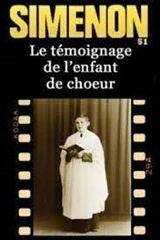Locked Room International, 2013. Book Format: Kindle Edition. File Size: 688 KB. Print Length: 144 pages. ASIN: B00HET2Y5Y. ISBN: N/A.
The Night of the Wolf is a collection of short stories translated from the French by Robert Adey and John Pugmire, not to be confused with the short story of the same name. It was first published in French in 2000 by Edition du Masque – Hachette Livre as La Nuit du Loup and the first English language edition was published by Wildside Press in 2006. The English edition differs from the original French edition since one of the original short stories, “Un rendez-vous aussi saugrenu”, was dropped because it was impossible to translate into English, and two others were added to the English edition to bring the total up to ten, these stories are “L’Abominable bonhomme de neige” (“The Abominable Snowman”) and “Le Spectre doré” (“The Golden Ghost”). My edition is a republication of the original The Night of the Wolf, first published in 2006 by Locked Room International.
 Publisher’s Description: Coffins dancing in a hermetically sealed crypt; a tunnel that murders people; a werewolf killer who leaves no trace on the snow; a victim killed by an invisible hand at the top of a guarded tower; a homicidal snowman that kills in front of witnesses… There cannot be a rational explanation for these and other hideous crimes; and yet there is. Each story is a glittering example of the brilliant plotting and atmosphere of foreboding that characterized the Golden Age of detective fiction.
Publisher’s Description: Coffins dancing in a hermetically sealed crypt; a tunnel that murders people; a werewolf killer who leaves no trace on the snow; a victim killed by an invisible hand at the top of a guarded tower; a homicidal snowman that kills in front of witnesses… There cannot be a rational explanation for these and other hideous crimes; and yet there is. Each story is a glittering example of the brilliant plotting and atmosphere of foreboding that characterized the Golden Age of detective fiction.
My Take: Although I’m trying to read French, I’m not yet proficient enough to fully appreciate Paul Halter’s books, so I decided to read the English edition translated by Robert Adey and John Pugmire. That said, I am not going to repeat here the summaries of each of the stories that make up this volume. Just read some of the reviews in the links below. For my taste, my favourites have been “‘The Cleaver” (“La hache”) and the one that gives the collection its title, “The Night of the Wolf” (“La nuit du loup”). I also enjoyed “The Dead Dance at Night” (“Les morts dansent la nuit”) and “The Call of the Lorelei” (“L’appel de la Lorelei”). The rest of the stories that make up this volume are: “The Abominable Snowman” (“L’abominable homme de neige”), “The Golden Ghost” (“Le spectre doré”), “The Tunnel of Death” (“L’escalier assassin”),”The Flower Girl” (“La marchande de fleurs”), “Rippermania” (“Ripperomanie”) and “Murder in Cognac” (“Meurtre à Cognac”). All in all an excellent opportunity to become acquaintance with Paul Halter’s universe
The Night of the Wolf has been reviewed, among others, by Patrick at ”At the Scene of the Crime”, Pietro De Palma at ”Death Can Read”, Brad Friedman at ”Ah Sweet Mystery!”, Christian Henriksson at ”Mysteries, Short and Sweet”, Jim Noy at ”The Invisible Event” and Les Blatt at ”Classic Mysteries”.
 About the Author: Paul Halter is a French author of detective novels born in 1956. An unconditional fan of John Dickson Carr but also of James Hadley Chase, he entered literature in 1986 with La Malédiction de Barberousse, self-published, and then with La quatrième porte, which won the Prix du Roman Policier in 1987. The following year, Le brouillard rougech won the French Prix du Roman d’Aventures in 1988. His career was launched and since then he has published some forty novels that make him the French-speaking master of impossible crime, following in the footsteps of John Dickson Carr or Clayton Rawson. He created two characters in the series: Dr Alan Twist, an eminent criminologist, and Owen Burns, a Victorian aesthete inspired by Oscar Wilde. He also published several novels without recurring characters, as well as a collection of short stories, La nuit du loup.
About the Author: Paul Halter is a French author of detective novels born in 1956. An unconditional fan of John Dickson Carr but also of James Hadley Chase, he entered literature in 1986 with La Malédiction de Barberousse, self-published, and then with La quatrième porte, which won the Prix du Roman Policier in 1987. The following year, Le brouillard rougech won the French Prix du Roman d’Aventures in 1988. His career was launched and since then he has published some forty novels that make him the French-speaking master of impossible crime, following in the footsteps of John Dickson Carr or Clayton Rawson. He created two characters in the series: Dr Alan Twist, an eminent criminologist, and Owen Burns, a Victorian aesthete inspired by Oscar Wilde. He also published several novels without recurring characters, as well as a collection of short stories, La nuit du loup.
Bibliography in English:
Dr Twist and Chief Inspector Hurst novels:
- La quatrième porte (The Fourth Door) 1987
- La mort vous invite (Death Invites You) 1988
- La chambre du fou (The Madman’s Room) 1990
- La tête du tigre (The Tiger’s Head) 1991
- La septième hypothèse (The Seventh Hypothesis) 1991
My blog post is here. - Le diable de Dartmoor (The Demon of Dartmoor) 1993
- L’image trouble (The Blurred Image) 1995 (Translated as The Picture from the Past, Locked Room International, 2014)
- L’arbre aux doigts tordus (The Tree with Twisted Fingers) 1996 (Translated as The Vampire Tree, Locked Room International, 2016)
- L’homme qui aimait les nuages (The Man Who Loved Clouds) 1999
- Le toile de Pénélope (Penelope’s Web) 2001
- Les larmes de Sibyl (Sibyl’s Tears) 2005
Owen Burns and Achilles Stock novels:
- Le roi du désordre (The Lord of Misrule) 1994
- Les sept merveilles du crime (The Seven Wonders of Crime) 1997
- La ruelle fantôme (The Phantom Passage) 2005
- Le masque du vampire (The Mask of the Vampire) 2014
- La montre en or (The Gold Watch) 2019
- La mystére de la dame blanche (The White Lady) 2020
Standalones:
- Le brouillard rouge (The Crimson Fog) 1988
- Le cercle invisible (The Invisible Circle) 1996
Short story collections:
- La nuit du loup (The Night of the Wolf) 2000
- The Helm of Hades 2019





